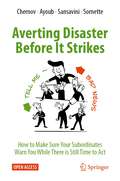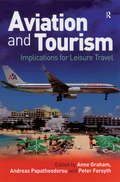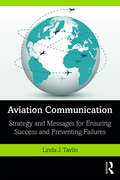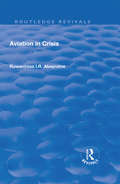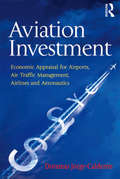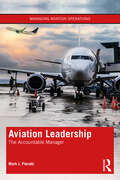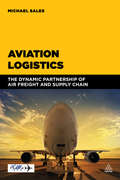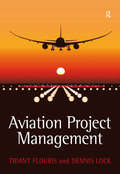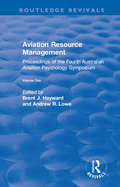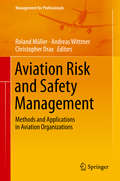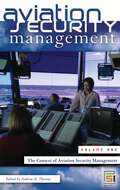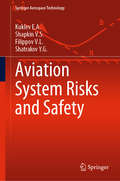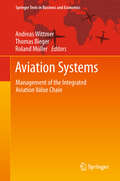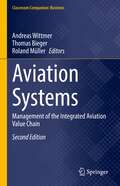- Table View
- List View
Averting Disaster Before It Strikes: How to Make Sure Your Subordinates Warn You While There is Still Time to Act
by Dmitry Chernov Ali Ayoub Giovanni Sansavini Didier SornetteSome of the major industrial disasters could have been prevented. When the facts of what happened are established, their stories share a common thread: before things spiralled out of control, there were workers at the affected sites who knew that the situation was dangerous, and could become catastrophic unless immediate action was taken. But tragically, nobody dared to tell the decision-makers who could have authorized that action. With no idea of the risks they were taking, the people in charge continued as normal… and disaster struck. Because vital information about risks could not flow freely from the shop floor to the director’s office, the crucial decisions were not made in time. This observation has been documented in the following major technological accidents: Challenger space shuttle explosion (USA, 1986); Chernobyl nuclear plant disaster (USSR, 1986); Deepwater Horizon oil spill (USA, 2010); Fukushima-1 nuclear power plant disaster (Japan, 2011); and numerous other industrial disasters. After accidents like these, losses and costs for dealing with the consequences are often hundreds — or even thousands — of times greater than the finances that would have been required to deal with the risks when they were first recognized.This handbook is about how to transform the way large critical infrastructure companies communicate about safety and technological risks. It aims to support senior managers to get the information they need from their subordinates concerning the risks they are facing, in order to prevent accidents before it is too late.The recommendations in this handbook are based on interviews with 100 executives at various levels, working in 65 critical infrastructure companies around the world, in power, oil and gas, metals, chemicals and petrochemicals, mining and other industries.The recommendations of these leaders were also tested in the pilot project, in an industrial company which is the world leader in its sector. More than 400 managers at various levels of the corporate hierarchy, and employees at several of the company’s industrial plants, took part in the project.This open access handbook is written for the owners, senior managers, and industrial safety directors of critical infrastructure companies.
Aviation and Tourism: Implications for Leisure Travel
by Anne Graham Andreas Papatheodorou Peter ForsythTransport is an essential element of tourism, providing the vital link between the tourist generating areas and destinations. Good accessibility, which is determined by the transport services provided, is a fundamental condition for the development of any tourist destination. Moreover the transport industry can be a major beneficiary of tourism because of the additional passenger demand that may be generated. Aviation is an increasingly important mode of transport for tourism markets. Whilst geography has meant that, in modern times, air travel has always been the dominant mode for long distance travel and much international tourism, moves towards deregulation, and in particular the emergence of the low cost carrier sector, have also increased aviation's significance for short and medium haul tourism trips. Thus developments in aviation can have very major implications for many leisure and business tourism markets. However the characteristics and needs of leisure travellers are generally so very different from business travellers that this necessitates a separate consideration of these markets if a detailed understanding of the relationship with aviation is to be gained. In spite of the obvious closeness between the aviation and tourism industries, there are very few specialist texts on this subject. Most tourism focused books consider aviation as just one component of the tourism industry which needs to be discussed, whereas aviation specialist texts rarely concentrate on just leisure travel. In addition there is very little literature that gives a detailed appreciation of the complexities and potential conflicts associated with the development of coherent and effective aviation and tourism policies. Therefore it is the aim of this book to fill this important gap which exists with a comprehensive, in-depth study of the relationship between aviation and leisure travel. The book deals exclusively with issues related to the relationship between aviation and leisure travel. It does this with an analysis of the theoretical concepts relevant to the subject area combined with a detailed investigation of current practice within the aviation and tourism industries. Each chapter is illustrated with case study material that will reinforce the understanding of the issues that are being examined.
Aviation and Tourism: Implications for Leisure Travel
by Anne Graham Andreas Papatheodorou Peter ForsythTransport is an essential element of tourism, providing the vital link between the tourist generating areas and destinations. Good accessibility, which is determined by the transport services provided, is a fundamental condition for the development of any tourist destination. Moreover the transport industry can be a major beneficiary of tourism because of the additional passenger demand that may be generated. Aviation is an increasingly important mode of transport for tourism markets. Whilst geography has meant that, in modern times, air travel has always been the dominant mode for long distance travel and much international tourism, moves towards deregulation, and in particular the emergence of the low cost carrier sector, have also increased aviation's significance for short and medium haul tourism trips. Thus developments in aviation can have very major implications for many leisure and business tourism markets. However the characteristics and needs of leisure travellers are generally so very different from business travellers that this necessitates a separate consideration of these markets if a detailed understanding of the relationship with aviation is to be gained. In spite of the obvious closeness between the aviation and tourism industries, there are very few specialist texts on this subject. Most tourism focused books consider aviation as just one component of the tourism industry which needs to be discussed, whereas aviation specialist texts rarely concentrate on just leisure travel. In addition there is very little literature that gives a detailed appreciation of the complexities and potential conflicts associated with the development of coherent and effective aviation and tourism policies. Therefore it is the aim of this book to fill this important gap which exists with a comprehensive, in-depth study of the relationship between aviation and leisure travel. The book deals exclusively with issues related to the relationship between aviation and leisure travel. It does this with an analysis of the theoretical concepts relevant to the subject area combined with a detailed investigation of current practice within the aviation and tourism industries. Each chapter is illustrated with case study material that will reinforce the understanding of the issues that are being examined.
Aviation Communication: Strategy and Messages for Ensuring Success and Preventing Failures
by Linda J. TavlinDo you ever wonder why an airline’s communication strategy can crash and burn in a crisis? A lack of understanding an acceptable aviation communication strategy can, in this fast world of social media, ruin a company’s credibility in the aviation industry. Aviation Communication: Strategy and Messages for Ensuring Success and Preventing Failures is the first go-to book to reveal to everyone in the aviation industry how to stop an organization’s communication strategy from becoming the tragedy-after-the-tragedy that we’ve seen so often. In such instances, after the media go home, the economic, political, regulatory, and legal effects can linger for years. The strategies and messages in this book show how to prevent this along with the ultimate safety net used by those who have been successful. Readers will learn to prevent catastrophic communication mistakes with strategic templates for a wide array of scenarios, as well as 25 specific techniques that give the actual words to use to deliver the book’s messages. This book is a must-have for the international aviation business community as a tri-functional induction, training, and reference tool.
Aviation Communication: Strategy and Messages for Ensuring Success and Preventing Failures
by Linda J. TavlinDo you ever wonder why an airline’s communication strategy can crash and burn in a crisis? A lack of understanding an acceptable aviation communication strategy can, in this fast world of social media, ruin a company’s credibility in the aviation industry. Aviation Communication: Strategy and Messages for Ensuring Success and Preventing Failures is the first go-to book to reveal to everyone in the aviation industry how to stop an organization’s communication strategy from becoming the tragedy-after-the-tragedy that we’ve seen so often. In such instances, after the media go home, the economic, political, regulatory, and legal effects can linger for years. The strategies and messages in this book show how to prevent this along with the ultimate safety net used by those who have been successful. Readers will learn to prevent catastrophic communication mistakes with strategic templates for a wide array of scenarios, as well as 25 specific techniques that give the actual words to use to deliver the book’s messages. This book is a must-have for the international aviation business community as a tri-functional induction, training, and reference tool.
Aviation in Crisis
by Ruwantissa AbeyratneThis title was first published in 2003. The events of 11 September 2001 defy modern economic theory when addressed in aviation terms. Economic theory would suggest that, once the impact of such events are a thing of the past, and economies are restored to their status quo ante, a rise in the gross domestic product of States to earlier levels would almost inevitably result in increased consumption. This in turn would mean that the demand for air travel would rise to earlier proportions and consumption in terms of air transport services would be restored to normalcy. However, the September attacks on United States' property introduced a unique characteristic through the fear factor that directly impacts the future development of air transport. As a result, the grim task of restoration of passenger confidence stands in the way of economic revival of the air transport industry. Aviation was always in crisis. The air transport industry, even prior to 11 September 2001, although seemingly a glamorous, exciting and prosperous business, never enjoyed sustained periods of profitability. Even among the large carriers, a short bout of profitability would inevitably be followed by a period of downturn in real income. It is simply that this fluctuation in fortune is an ineluctable characteristic of air transport, whose fortunes are dictated by rigid regulation, competition and technological change. If a sustained analysis were to be made of air transport, plain economic theory would no longer be the exclusive discipline for consideration. Rather, all relevant factors have to be taken in context and emerging issues should be analyzed as possible threats to the economic well being of the air transport industry. This book addresses issues in a post-September 2001 context but also analyses issues past and present, with the intent of looking at the future. Four major areas are taken into consideration which were in crisis but are truly impacted by the events of September 2001. These areas relate to crises in the commercial, security, insurance and environmental protection fields. Of these the first and fourth areas are inextricably intertwined, as aircraft noise regulations in various States have a direct impact on aircraft financing, which in turn is linked to demand for air services. A drop in demand for air services would essentially mean that the demand for lease or purchase of new aircraft would drop. When this occurs, air transport enterprises would be more inclined to cut costs and therefore concentrate on using the aircraft already at hand, upgrading them to conform to the The purpose of this book is to view the overall picture of an aviation industry - comprising air transport and other aviation related industries - in crisis, through issues that continue to impact the economic viability of air transport, particularly as a result of the events of 11 September 2001.
Aviation in Crisis
by Ruwantissa AbeyratneThis title was first published in 2003. The events of 11 September 2001 defy modern economic theory when addressed in aviation terms. Economic theory would suggest that, once the impact of such events are a thing of the past, and economies are restored to their status quo ante, a rise in the gross domestic product of States to earlier levels would almost inevitably result in increased consumption. This in turn would mean that the demand for air travel would rise to earlier proportions and consumption in terms of air transport services would be restored to normalcy. However, the September attacks on United States' property introduced a unique characteristic through the fear factor that directly impacts the future development of air transport. As a result, the grim task of restoration of passenger confidence stands in the way of economic revival of the air transport industry. Aviation was always in crisis. The air transport industry, even prior to 11 September 2001, although seemingly a glamorous, exciting and prosperous business, never enjoyed sustained periods of profitability. Even among the large carriers, a short bout of profitability would inevitably be followed by a period of downturn in real income. It is simply that this fluctuation in fortune is an ineluctable characteristic of air transport, whose fortunes are dictated by rigid regulation, competition and technological change. If a sustained analysis were to be made of air transport, plain economic theory would no longer be the exclusive discipline for consideration. Rather, all relevant factors have to be taken in context and emerging issues should be analyzed as possible threats to the economic well being of the air transport industry. This book addresses issues in a post-September 2001 context but also analyses issues past and present, with the intent of looking at the future. Four major areas are taken into consideration which were in crisis but are truly impacted by the events of September 2001. These areas relate to crises in the commercial, security, insurance and environmental protection fields. Of these the first and fourth areas are inextricably intertwined, as aircraft noise regulations in various States have a direct impact on aircraft financing, which in turn is linked to demand for air services. A drop in demand for air services would essentially mean that the demand for lease or purchase of new aircraft would drop. When this occurs, air transport enterprises would be more inclined to cut costs and therefore concentrate on using the aircraft already at hand, upgrading them to conform to the The purpose of this book is to view the overall picture of an aviation industry - comprising air transport and other aviation related industries - in crisis, through issues that continue to impact the economic viability of air transport, particularly as a result of the events of 11 September 2001.
Aviation Investment: Economic Appraisal for Airports, Air Traffic Management, Airlines and Aeronautics
by Doramas Jorge-CalderonAviation Investment uniquely addresses investment appraisal methods across the key industries that make up the aviation sector, including the airports, air traffic management, airline and aircraft manufacturing - or aeronautic - industries. It is a practice-oriented book where methods are presented through realistic case studies. The emphasis is on economic appraisal, or cost-benefit analysis, in order to determine the viability of projects not only for private investors but for society as a whole. Financial (cash flow) appraisal is illustrated alongside economic appraisal, as the latter builds on the former, but also to show how economic appraisal enhances standard financial appraisal to determine the long-term sustainability of any investment. Aviation is a capital-intensive sector that is growing rapidly, with world traffic expected to double over the next 15 years or so. A great deal of economic appraisal of investment projects takes place already, as aviation is subject to government intervention through economic regulation and financial support, and as both investors and policy makers seek to understand issues such as how environmental legislation may impact the viability of investments. Both economic growth and welfare go hand in hand with sound investment decisions, particularly regarding sectors such as aviation where investments are large and almost invariably debt-financed. Aviation Investment offers all aviation sub-sectors a single-source reference, bringing together the theoretical background of the economic appraisal literature and aviation investment in practice. It is written in a style that is accessible to non-academic professionals, using formulae only where strictly necessary to enable practical applications, and benefits from the substantial practical experience of the author.
Aviation Investment: Economic Appraisal for Airports, Air Traffic Management, Airlines and Aeronautics
by Doramas Jorge-CalderonAviation Investment uniquely addresses investment appraisal methods across the key industries that make up the aviation sector, including the airports, air traffic management, airline and aircraft manufacturing - or aeronautic - industries. It is a practice-oriented book where methods are presented through realistic case studies. The emphasis is on economic appraisal, or cost-benefit analysis, in order to determine the viability of projects not only for private investors but for society as a whole. Financial (cash flow) appraisal is illustrated alongside economic appraisal, as the latter builds on the former, but also to show how economic appraisal enhances standard financial appraisal to determine the long-term sustainability of any investment. Aviation is a capital-intensive sector that is growing rapidly, with world traffic expected to double over the next 15 years or so. A great deal of economic appraisal of investment projects takes place already, as aviation is subject to government intervention through economic regulation and financial support, and as both investors and policy makers seek to understand issues such as how environmental legislation may impact the viability of investments. Both economic growth and welfare go hand in hand with sound investment decisions, particularly regarding sectors such as aviation where investments are large and almost invariably debt-financed. Aviation Investment offers all aviation sub-sectors a single-source reference, bringing together the theoretical background of the economic appraisal literature and aviation investment in practice. It is written in a style that is accessible to non-academic professionals, using formulae only where strictly necessary to enable practical applications, and benefits from the substantial practical experience of the author.
Aviation Leadership: The Accountable Manager (Managing Aviation Operations)
by Mark J. PierottiThis book identifies the responsibilities of management in the regulatory territories of the FAA (USA), the EASA (European Union) and the GCAA (UAE), identifying the daily challenges of leadership in ensuring their company is meeting the regulatory obligations of compliance, safety and security that will satisfy the regulator while also meeting the fiducial responsibilities of running an economically viable and efficient lean company that will satisfy the shareholders. Detailing each responsibility of the Accountable Manager, the author breaks them down to understandable and achievable elements where methods, systems and techniques can be applied to ensure the role holder is knowledgeable of accountabilities and is confident that they are not only compliant with the civil aviation regulations but also running an efficient and effective operation. This includes the defining of an Accountable Manager "tool kit" as well as possible software "dashboards" that focus the Accountable Manager on the important analytics, such as the information and data available, as well as making the maximum use of their expert post holder team. This book will be of interest to leadership of all aviation- related companies, such as airlines, charter operators, private and executive operators, flying schools, aircraft and component maintenance facilities, aircraft manufacturers, engine manufacturers, component manufacturers, regulators, legal companies, leasing companies, banks and finance houses, departments of transport, etc; any relevant organisation regulated and licensed by civil aviation authority. It can also be used by students within a wide range of aviation courses at colleges, universities and training academies.
Aviation Leadership: The Accountable Manager (Managing Aviation Operations)
by Mark J. PierottiThis book identifies the responsibilities of management in the regulatory territories of the FAA (USA), the EASA (European Union) and the GCAA (UAE), identifying the daily challenges of leadership in ensuring their company is meeting the regulatory obligations of compliance, safety and security that will satisfy the regulator while also meeting the fiducial responsibilities of running an economically viable and efficient lean company that will satisfy the shareholders. Detailing each responsibility of the Accountable Manager, the author breaks them down to understandable and achievable elements where methods, systems and techniques can be applied to ensure the role holder is knowledgeable of accountabilities and is confident that they are not only compliant with the civil aviation regulations but also running an efficient and effective operation. This includes the defining of an Accountable Manager "tool kit" as well as possible software "dashboards" that focus the Accountable Manager on the important analytics, such as the information and data available, as well as making the maximum use of their expert post holder team. This book will be of interest to leadership of all aviation- related companies, such as airlines, charter operators, private and executive operators, flying schools, aircraft and component maintenance facilities, aircraft manufacturers, engine manufacturers, component manufacturers, regulators, legal companies, leasing companies, banks and finance houses, departments of transport, etc; any relevant organisation regulated and licensed by civil aviation authority. It can also be used by students within a wide range of aviation courses at colleges, universities and training academies.
Aviation Logistics: The Dynamic Partnership of Air Freight and Supply Chain
by Michael SalesAviation Logistics looks at the function of the air cargo business and its role in global supply chains and logistics. As global economies are constantly evolving, the supply chain business with its transport partners must be proactive for the future. Technology and its resulting efficiency and transparency are therefore a central part of this book. Aviation Logistics examines how carriers are coming up with new methods and technologies to improve ground handling and road transport, traceability systems and barcoding, security and screening, and safe delivery of perishable items (such as in the pharmaceutical and medical sectors). Endorsed by The International Air Cargo Association (TIACA), Aviation Logistics is supplemented with case studies and contributions from a team of experts including Oliver Evans and Stan Wraight, both industry experts.Online resources available: Air Cargo News' Freighter Directory.
Aviation Logistics: The Dynamic Partnership of Air Freight and Supply Chain
by Michael SalesAviation Logistics looks at the function of the air cargo business and its role in global supply chains and logistics. As global economies are constantly evolving, the supply chain business with its transport partners must be proactive for the future. Technology and its resulting efficiency and transparency are therefore a central part of this book. Aviation Logistics examines how carriers are coming up with new methods and technologies to improve ground handling and road transport, traceability systems and barcoding, security and screening, and safe delivery of perishable items (such as in the pharmaceutical and medical sectors). Endorsed by The International Air Cargo Association (TIACA), Aviation Logistics is supplemented with case studies and contributions from a team of experts including Oliver Evans and Stan Wraight, both industry experts.Online resources available: Air Cargo News' Freighter Directory.
Aviation Project Management
by Triant G. Flouris Dennis LockCombining the considerable respective expertise of Triant Flouris and Dennis Lock, this unique book highlights the ways that successful businesses are managed in the aviation industry through the identification and application of proven project management methods. Theoretical concepts are defined, clarified and shown how they can be valuable to business managers and students of the aviation business sector. Aviation Project Management builds on the successful and popular work of Dennis Lock but is considerably enhanced by applications, examples, illustrations and case examples pertaining to projects exclusively from the aviation industry. Theory in the project management field is already well evolved, so the purpose of this book is not to review that theory but rather to demonstrate how the lessons of theory can be of practical use to aviation students and business managers. It provides a practical guide to those interested in how projects are managed and the common mistakes that aviation project managers should avoid.
Aviation Project Management
by Triant G. Flouris Dennis LockCombining the considerable respective expertise of Triant Flouris and Dennis Lock, this unique book highlights the ways that successful businesses are managed in the aviation industry through the identification and application of proven project management methods. Theoretical concepts are defined, clarified and shown how they can be valuable to business managers and students of the aviation business sector. Aviation Project Management builds on the successful and popular work of Dennis Lock but is considerably enhanced by applications, examples, illustrations and case examples pertaining to projects exclusively from the aviation industry. Theory in the project management field is already well evolved, so the purpose of this book is not to review that theory but rather to demonstrate how the lessons of theory can be of practical use to aviation students and business managers. It provides a practical guide to those interested in how projects are managed and the common mistakes that aviation project managers should avoid.
Aviation Resource Management: Proceedings of the Fourth Australian Aviation Psychology Symposium Volume 1 (Routledge Revivals)
by BRENT J. HAYWARD AND ANDREW R. LOWEThis title was first published in 2000. This is volume one of a two-volume set which presents the reader with strategies for the contributions of psychology and human factors to the safe and effective functioning of aviation organizations and systems.Together, the volumes comprise the edited contributions to the Fourth Australian Aviation Psychology Symposium. The chapters within are orientated towards presenting and developing practical solutions for the present and future challenges facing the aviation industry. Each volume covers areas of vital and enduring importance in the complex aviation system. Volume one includes aviation safety, crew resource management, the aircraft cabin, cockpit automation, safety investigation, fatigue and stress, and applied human factors in training.
Aviation Resource Management: Proceedings of the Fourth Australian Aviation Psychology Symposium Volume 1 (Routledge Revivals)
by Brent J. Hayward Andrew R. LoweThis title was first published in 2000. This is volume one of a two-volume set which presents the reader with strategies for the contributions of psychology and human factors to the safe and effective functioning of aviation organizations and systems.Together, the volumes comprise the edited contributions to the Fourth Australian Aviation Psychology Symposium. The chapters within are orientated towards presenting and developing practical solutions for the present and future challenges facing the aviation industry. Each volume covers areas of vital and enduring importance in the complex aviation system. Volume one includes aviation safety, crew resource management, the aircraft cabin, cockpit automation, safety investigation, fatigue and stress, and applied human factors in training.
Aviation Risk and Safety Management: Methods and Applications in Aviation Organizations (Management for Professionals)
by Roland Müller Andreas Wittmer Christopher DraxThe International Civil Aviation Organization’s (ICAO) decision to require aviation organizations to adopt Safety Management Systems poses a major problem especially for small and medium sized aviation companies. The complexity of regulations overstrains the aviation stakeholders who seek to fully advantage from them but have no clear guidance. The aim of the book is to show the implementation of such a new system with pragmatic effort in order to gain a gradation for smaller operators. This approach should illustrate the leeway in order to adapt the processes and to show the interfaces between Corporate Risk Management and Safety Management. The book shows how to build a system with reasonable effort, appropriate to the size and complexity of the specific operator. It also gives inputs on the key aspects and how to effectively operate such a system with the various interfaces. Furthermore, the book highlights the importance of Corporate Risk Management independent of Safety Management Systems based on ICAO.
Aviation Security Management [3 volumes]: [3 volumes] (Praeger Security International)
Because of 9/11, there is universal recognition that aviation security is a deadly serious business. Still, around the world today, the practice of aviation security is rooted in a hodgepodge of governmental rules, industry traditions, and local idiosyncrasies. In fact, nearly seven years after the largest single attack involving the air transport industry, there remains no viable framework in place to lift aviation security practice out of the mishmash that currently exists. It is the ambitious intent of Aviation Security Management to change that. The goals of this set are nothing less than to make flying safer, to make transporting goods by air safer, and to lay the foundation for the professionalization of this most important field.This dynamic set showcases the most current trends, issues, ideas, and practices in aviation security management, especially as the field evolves in the context of globalization and advances in technology. Written by leading academic thinkers, practitioners, and former and current regulators in the field, the three volumes highlight emerging and innovative practices, illustrated with examples from around the world. Volume 1 takes a penetrating look at the overall framework in which aviation security management has taken place in the past and will likely do so in the foreseeable future. It covers the major areas of focus for anyone in the aviation security business, and it provides a basis for educational programs. Volume 2 delves into the emerging issues affecting aviation security managers right now. Volume 3: Perspectives on Aviation Security Management covers the full spectrum of international aviation security-related issues. It will serve as part of the foundation for the next generation of research in the area in both a business and cultural context. Collectively, these volumes represent the state of the art in the field today and constitute an essential resource for anyone practicing, studying, teaching, or researching aviation security management.
Aviation System Risks and Safety (Springer Aerospace Technology)
by Kuklev E.A. Shapkin V.S. Filippov V.L. Shatrakov Y.G.This book provides a solution to “rare event” problems without using the classical theory of reliability and theory of probability. This solution is based on the methodology of risk assessment as “measure of danger” (in keeping with the ICS RAS) and an expert approach to determining systems’ safety indications using Fuzzy Sets methods. Further, the book puts forward a new concept: “Reliability, Risks, and Safety” (RRS). The book’s main goal is to generalize present results and underscore the need to develop an alternative approach to safety level assessment and risk management for technical (aviation) systems in terms of Fuzzy Sets objects, in addition to traditional probabilistic safety analysis (PSA). The concept it proposes incorporates ICAO recommendations regarding proactive system control and the system’s responses to various internal and external disturbances.
Aviation Systems: Management of the Integrated Aviation Value Chain (Springer Texts in Business and Economics)
by Andreas Wittmer, Thomas Bieger and Roland MüllerThis book aims to provide comprehensive coverage of the field of air transportation, giving attention to all major aspects, such as aviation regulation, economics, management and strategy. The book approaches aviation as an interrelated economic system and in so doing presents the “big picture” of aviation in the market economy. It explains the linkages between domains such as politics, society, technology, economy, ecology, regulation and how these influence each other. Examples of airports and airlines, and case studies in each chapter support the application-oriented approach. Students and researchers in business administration with a focus on the aviation industry, as well as professionals in the industry looking to refresh or broaden their knowledge of the field will benefit from this book.
Aviation Systems: Management of the Integrated Aviation Value Chain (Classroom Companion: Business)
by Andreas Wittmer Thomas Bieger Roland MüllerThis book provides an overview of the aviation sector by focusing on all major aspects embedded in the environment (subsystems) and the market of aviation. The book explains the linkages between subsystems politics, society, technology, economy, environment, and regulation, and how these subsystems influence each other and the market. The book starts by describing the aviation system, then focuses on the supply side and the demand side of the system and in a final part focuses on steering and controlling the system of aviation from a managerial, economic, and regulatory perspective. Examples and case studies of airports, airlines, and the production industry in each chapter support the application-oriented approach. The summary and review questions help the reader to understand the focus and main messages of each chapter. Students and researchers in business administration with a focus on aviation, as well as professionals in the industry looking to refresh or broaden their knowledge in the field will benefit from this book.
Avocado Anxiety: and Other Stories About Where Your Food Comes From
by Louise GrayThe food stories behind your favourite fruits and vegetables. Have you ever wondered who picked your Fairtrade banana? Or why we can buy British strawberries in April? How far do you think your green beans travelled to get to your plate? And where do all the wonky carrots go? Above all, how do we stop worrying about our food choices and start making decisions that make a difference?In an effort to make sense of the complex food system we are all part of, Louise Gray decides to track the stories of our five-a-day, from farm to fruit bowl, and discover the impact that growing fruits and vegetables has on the planet. Through visits to farms, interviews with scientists and trying to grow her own, she digs up the dirt behind organic potatoes, greenhouse tomatoes and a glut of courgettes. In each chapter, Louise answers a question about a familiar item in our shopping basket. Is plant protein as good as meat? Is foraged food more nutritious? Could bees be the answer to using fewer chemicals? How do we save genetic diversity in our apples? Are digital apps the key to reducing food waste? Is gardening good for mental health? And is the symbol of clean eating, the avocado, fuelling the climate crisis? As pressure grows via social media to post pictures of food that ticks all the boxes in terms of health and the environment, these food stories from the author of the award-winning The Ethical Carnivore are also a personal story of motherhood and the realisation that nothing is ever perfect.
Avocado Anxiety: and Other Stories About Where Your Food Comes From
by Louise GrayThe food stories behind your favourite fruits and vegetables. Have you ever wondered who picked your Fairtrade banana? Or why we can buy British strawberries in April? How far do you think your green beans travelled to get to your plate? And where do all the wonky carrots go? Above all, how do we stop worrying about our food choices and start making decisions that make a difference?In an effort to make sense of the complex food system we are all part of, Louise Gray decides to track the stories of our five-a-day, from farm to fruit bowl, and discover the impact that growing fruits and vegetables has on the planet. Through visits to farms, interviews with scientists and trying to grow her own, she digs up the dirt behind organic potatoes, greenhouse tomatoes and a glut of courgettes. In each chapter, Louise answers a question about a familiar item in our shopping basket. Is plant protein as good as meat? Is foraged food more nutritious? Could bees be the answer to using fewer chemicals? How do we save genetic diversity in our apples? Are digital apps the key to reducing food waste? Is gardening good for mental health? And is the symbol of clean eating, the avocado, fuelling the climate crisis? As pressure grows via social media to post pictures of food that ticks all the boxes in terms of health and the environment, these food stories from the author of the award-winning The Ethical Carnivore are also a personal story of motherhood and the realisation that nothing is ever perfect.
The Avocado Debate (Changing Planet)
by Honor May EldridgeWhether smashed on toast or hailed as a superfood, the avocado has taken the world by storm, but what are the environmental and social impacts of this trendy fruit? This book does not seek to demonise the avocado and its many enthusiasts. Instead, it will illuminate consumers on the often unseen impacts of foods. A staple of cafes, restaurants, homes, and social media channels, demand for the avocado has grown exponentially over the past thirty years. From an everyday crop in South and Central America to a global phenomenon, this drastic change in demand has many consequences for people and the planet. As demand grows, so does the need for more land, with land clearances threatening habitats and biodiversity. As production grows, so does global distribution and the impacts that air and sea travel have on the environment. The shift from a local to a global product disturbs the local food system, raising serious questions around food sovereignty and food justice and the importance of establishing an agricultural system that is both environmentally and socially just. While focusing here on the avocado, this book allows readers to gain a better understanding of the food system as a whole. In doing so, it empowers us all to think carefully and critically about the environmental and ethical implications of our food choices more broadly. We shouldn’t feel guilty about eating avocados, we should simply understand the impact of doing so. This book is essential reading for all who are interested in learning more about the food system, sustainable diets, and the relationship between farming and the environment.
